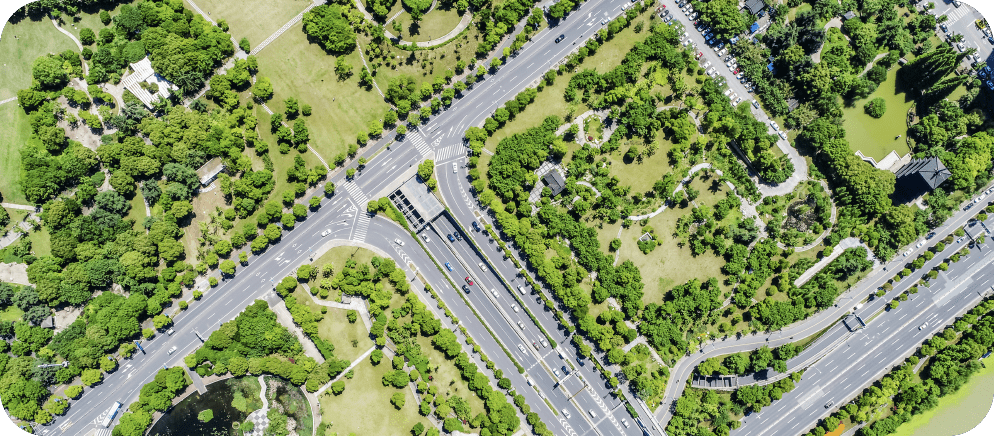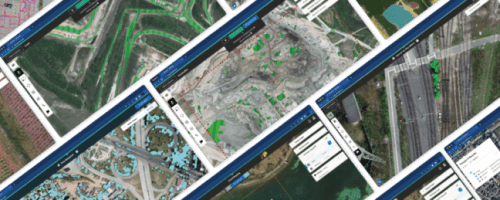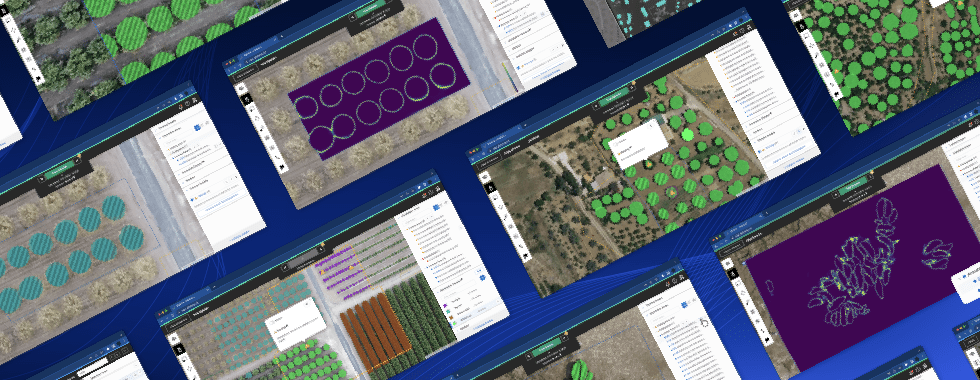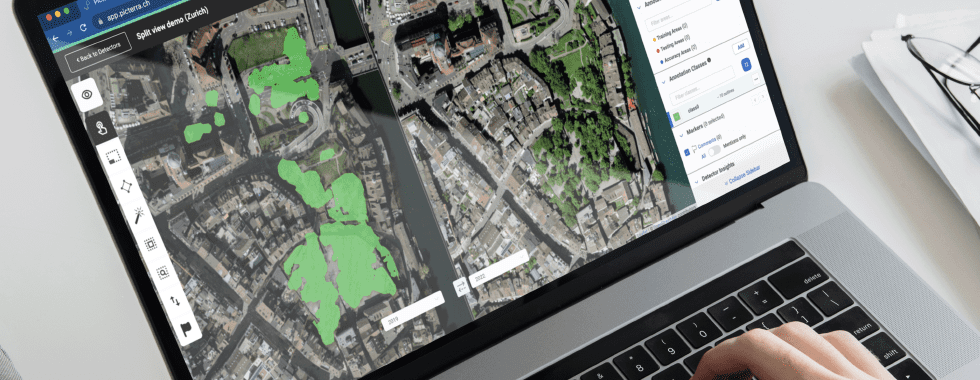Step outside your home, and you’re likely surrounded by trees, whether you are living in an urban or rural environment. They come in various forms, each contributing to the natural beauty of our surroundings. However, the significance of trees extends far beyond aesthetics; their existence is fundamental to our survival.
In this blog, we delve into the multifaceted importance of trees, emphasising their pivotal role in our cities and in combating global warming and carbon emissions. We go a step further, using external data alongside Picterra’s geospatial intelligence solutions to illustrate which of 26 global cities are most in need of trees to sequester the estimated CO2 they produce each year.
Environmental guardians
Wildlife sanctuaries
Human health and well-being
Community cohesion
Planting for our future
Sequestering carbon: A path to climate resilience
Innovations in forestry management
Environmental guardians
Wildlife sanctuaries
Human health and well-being
Community cohesion
Planting for our future
Sequestering carbon: A path to climate resilience
Innovations in forestry management

Which cities are most in need of trees?
Using the 2022 total CO2 emissions for the world’s largest countries, we calculated the estimated total CO2 emissions produced per person, using population figures for the same year. With this, we were then able to calculate the estimated CO2 emissions for 26 major cities around the globe, by accounting for each city’s population count.
According to recent data sources, 6 trees are required to offset 1 tonne of CO2, meaning 1 tree can be estimated to be equivalent to 0.16 tonnes of CO2, which the team used to work out the number of trees that would be required to neutralize each city’s yearly CO2 emissions, alongside how many trees would be required per person.
The team then calculated the number of hectares that would be required per location by using tree planting density guidelines by the Woodland Trust which shows a tree can be planted every 2.5 meters per hectare. We used this data to estimate how many iconic locations, like Central Park, Hyde Park, etc, of trees would be required to offset emissions by dividing the total area of forestation required by the area of each location.
We then used Picterra’s geospatial AI detection platform, tree counting software, and forestry monitoring tools to map the number of trees currently present in the 26 global cities we have data for, to provide a supporting visualization of which cities are most in need of trees.
Based on this, we’ve created a league table ranking the cities that could need the most trees to the fewest.
| City | Total City CO2 (million tonnes) | No. of Trees to Neutralize City CO2 (millions) | No. of Hectares Required to sequester Total CO2 (millions) | No. of Trees Required Per Person (according to 2022 population figures) |
| Tokyo | 320.2 | 2001.5 | 1.25 | 51.7 |
| Beijing | 192.6 | 1203.9 | 0.75 | 53.1 |
| Moscow | 168.8 | 1054.8 | 0.66 | 79.9 |
| Seoul | 122.5 | 765.3 | 0.48 | 73.6 |
| New York | 113.9 | 711.9 | 0.44 | 86.6 |
| Toronto | 97.0 | 606.1 | 0.38 | 91.3 |
| Mexico City | 79.3 | 495.8 | 0.31 | 21.4 |
| Sydney | 77.4 | 483.9 | 0.30 | 90.7 |
| Montreal | 65.6 | 409.8 | 0.26 | 91.3 |
| Dubai | 65.4 | 408.8 | 0.26 | 130.5 |
| New Delhi | 62.9 | 393.2 | 0.25 | 11.5 |
| Buenos Aires | 61.5 | 384.4 | 0.24 | 23.8 |
| Cairo | 55.5 | 346.6 | 0.22 | 15.0 |
| Los Angeles | 54.4 | 340.2 | 0.21 | 86.6 |
| Singapore | 53.8 | 336.3 | 0.21 | 53.1 |
| Paris | 53.4 | 333.5 | 0.21 | 28.6 |
| London | 48.2 | 301.5 | 0.19 | 30.0 |
| Chicago | 37.7 | 235.4 | 0.15 | 86.6 |
| Cape Town | 33.0 | 206.3 | 0.13 | 40.5 |
| Hong Kong | 32.6 | 203.6 | 0.13 | 25.4 |
| Barcelona | 31.2 | 194.8 | 0.12 | 32.9 |
| Rio de Janeiro | 29.5 | 184.5 | 0.12 | 12.9 |
| Berlin | 29.2 | 182.3 | 0.11 | 49.0 |
| Milan | 17.3 | 108.0 | 0.07 | 32.9 |
| Lisbon | 12.2 | 76.3 | 0.05 | 24.4 |
| Rotterdam | 7.9 | 49.6 | 0.03 | 46.7 |
In each of the following visualisations we’ve used Picterra’s machine learning and geospatial AI tools to map and highlight the current number of trees present in each city centre. The areas flashing up in green are areas currently covered with trees.
Tokyo
Most in need of trees
Driven by Tokyo’s enormous population, it’s probably no surprise that the world’s biggest city needs the biggest injection of forestation to combat its carbon dioxide (CO2) emissions.
Omitting over 320 million tonnes of CO2 every year, Tokyo would have to plant over 2 billion trees, which would require a total of just over 1.25 million hectares of land.
Rotterdam
Demanding the fewest trees
At the opposite end of the spectrum, Rotterdam would require the fewest trees to neutralize its nearly 9 million tonnes of annual emissions, with nearly 50 million trees and just under 31,000 hectares required.
New York
1,304 more Central Parks required
Known for being home to one of the most visited city parks worldwide, New York came fifth in the rankings, needing the equivalent of 1,304 Central Parks to counteract its emissions.
London
A similar number of Hyde Park’s
Meanwhile, London, landing in seventeenth place, would have to reforest 1,330 Hyde Parks.
Dubai
The urban jungle
Renowned for its skyscrapers and modern architecture, Dubai came in tenth place overall, yet fared the worst for the number of trees required per person to offset its CO2 levels, at 130.5 trees for each resident.
Beijing
In second place
Based on our estimates Beijing would need to plant trees in an area roughly the size of 17,043 Tiananmen Squares.
Buenos Aires
Famous for the tango and its many parks and green spaces
The city is home to several beautiful parks, including the expansive Palermo Woods and the Japanese Gardens, providing residents and visitors with spaces for relaxation and recreation. Space equivalent to approximately 928 Palermo Woods, would be needed to plant trees in the required 240,000 hectares to sequester the city’s annual CO2 emissions.
Cairo
An oasis in the desert
Topping the list for Africa, the lifeblood of Cairo is the epic Nile River. It’s also synonymous with the ancient civilisation which grew on the river’s banks thousands of years ago. Trees would have to be planted in an area roughly the size of 271 Giza Plateaus, home to the Giza Pyramids, to sequester enough CO2 to offset the city’s annual emissions.
New Delhi
India’s capital
An area the size of roughly 12,146 India Gate Lawns would be required in New Delhi.
Sydney
Home to the Harbour Bridge
Australia’s landmark city would require trees occupying the space of 149 Sydney Harbours to offset its global CO2 emissions.
Moscow
162,911 Red Squares
Russia’s most populous city, Moscow’s Red Square at the heart of the city, is surrounded by iconic landmarks such as St. Basil’s Cathedral and the State Historical Museum. It would need to be planted more than 160,000 times over to sequester enough carbon dioxide.
Paris
La Ville Lumière
Paris is often referred to as “The City of Light” (“La Ville Lumière” in French). This nickname is believed to have originated during the Age of Enlightenment when Paris became a centre for literature, philosophy, and intellectual pursuits. One of its many landmarks is the Champs-Élysées, possibly the most famous avenue in the world, lined with shops, theatres, and cafes, leading to the Arc de Triomphe. It would take space equivalent to approximately 1,097 Champs-Élysées to plant enough trees to offset the city’s global CO2 emissions.
Limitations of our research
While our exploration into urban tree planting and carbon offsetting aims to be informative, it’s crucial to acknowledge the inherent limitations of our approach. The calculation of CO2 emissions per person relies on generalised figures for major cities, and the use of a universal conversion factor of six trees per tonne simplifies the intricate processes involved.
The estimation of required acres is based on standard tree planting density guidelines, overlooking the complexities of varying environmental conditions and urban constraints. Our comparison to well-known locations like Central Park serves as a visual aid but falls short of capturing the intricacies of land use, soil conditions, and ecosystem dynamics.
While interesting, we wanted to be clear that this study is more of a conceptual exploration than a precise scientific assessment, aimed at fostering awareness and dialogue on the potential impact of urban tree planting.


























